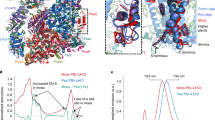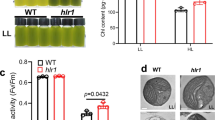Abstract
Plants, algae and cyanobacteria need to regulate photosynthetic light harvesting in response to the constantly changing light environment. Rapid adjustments are required to maintain fitness because of a trade-off between efficient solar energy conversion and photoprotection. The xanthophyll cycle, in which the carotenoid pigment violaxanthin is reversibly converted into zeaxanthin, is ubiquitous among green algae and plants and is necessary for the regulation of light harvesting, protection from oxidative stress and adaptation to different light conditions1,2. Violaxanthin de-epoxidase (VDE) is the key enzyme responsible for zeaxanthin synthesis from violaxanthin under excess light. Here we show that the Chlorophycean VDE (CVDE) gene from the model green alga Chlamydomonas reinhardtii encodes an atypical VDE. This protein is not homologous to the VDE found in plants and is instead related to a lycopene cyclase from photosynthetic bacteria3. Unlike the plant-type VDE that is located in the thylakoid lumen, the Chlamydomonas CVDE protein is located on the stromal side of the thylakoid membrane. Phylogenetic analysis suggests that CVDE evolved from an ancient de-epoxidase that was present in the common ancestor of green algae and plants, providing evidence of unexpected diversity in photoprotection in the green lineage.
This is a preview of subscription content, access via your institution
Access options
Subscribe to this journal
Receive 12 digital issues and online access to articles
$119.00 per year
only $9.92 per issue
Buy this article
- Purchase on Springer Link
- Instant access to full article PDF
Prices may be subject to local taxes which are calculated during checkout



Similar content being viewed by others
References
Demmig-Adams, B. Carotenoids and photoprotection in plants: a role for the xanthophyll zeaxanthin. Biochim. Biophys. Acta 1020, 1–24 (1990).
Jahns, P., Latowski, D. & Strzalka, K. Mechanism and regulation of the violaxanthin cycle: the role of antenna proteins and membrane lipids. Biochim. Biophys. Acta 1787, 3–14 (2009).
Maresca, J. A., Graham, J. E., Wu, M., Eisen, J. A. & Bryant, D. A. Identification of a fourth family of lycopene cyclases in photosynthetic bacteria. Proc. Natl Acad. Sci. USA 104, 11784–11789 (2007).
Niyogi, K. K. Photoprotection revisited: genetic and molecular approaches. Annu. Rev. Plant Physiol. Plant Mol. Biol. 50, 333–359 (1999).
Müller, P., Li, X.-P. & Niyogi, K. K. Non-photochemical quenching. A response to excess light energy. Plant Physiol. 125, 1558–1566 (2001).
Ruban, A. V., Johnson, M. P. & Duffy, C. D. P. The photoprotective molecular switch in the photosystem II antenna. Biochim. Biophys. Acta 1817, 167–181 (2012).
Niyogi, K. K. & Truong, T. B. Evolution of flexible non-photochemical quenching mechanisms that regulate light harvesting in oxygenic photosynthesis. Curr. Opin. Plant Biol. 16, 307–314 (2013).
Briantais, J. M., Vernotte, C., Picaud, M. & Krause, G. H. A quantitative study of the slow decline of chlorophyll a fluorescence in isolated chloroplasts. Biochim. Biophys. Acta 548, 128–138 (1979).
Casper-Lindley, C. & Björkman, O. Fluorescence quenching in four unicellular algae with different light-harvesting and xanthophyll-cycle pigments. Photosynth. Res. 56, 277–289 (1998).
Lunch, C. K. et al. The xanthophyll cycle and NPQ in diverse desert and aquatic green algae. Photosynth. Res. 115, 139–151 (2013).
Quaas, T. et al. Non-photochemical quenching and xanthophyll cycle activities in six green algal species suggest mechanistic differences in the process of excess energy dissipation. J. Plant Physiol. 172, 92–103 (2015).
Baroli, I., Do, A. D., Yamane, T. & Niyogi, K. K. Zeaxanthin accumulation in the absence of a functional xanthophyll cycle protects Chlamydomonas reinhardtii from photooxidative stress. Plant Cell 15, 992–1008 (2003).
Baroli, I. & Niyogi, K. K. Molecular genetics of xanthophyll-dependent photoprotection in green algae and plants. Phil. Trans. R. Soc. Lond. B 355, 1385–1394 (2000).
Havaux, M. & Niyogi, K. K. The violaxanthin cycle protects plants from photooxidative damage by more than one mechanism. Proc. Natl Acad. Sci. USA 96, 8762–8767 (1999).
Niyogi, K. K., Björkman, O. & Grossman, A. R. Chlamydomonas xanthophyll cycle mutants identified by video imaging of chlorophyll fluorescence quenching. Plant Cell 9, 1369–1380 (1997).
Niyogi, K. K., Grossman, A. R. & Björkman, O. Arabidopsis mutants define a central role for the xanthophyll cycle in the regulation of photosynthetic energy conversion. Plant Cell 10, 1121–1134 (1998).
Anwaruzzaman, M. et al. Genomic analysis of mutants affecting xanthophyll biosynthesis and regulation of photosynthetic light harvesting in Chlamydomonas reinhardtii. Photosynth Res. 82, 265–276 (2004).
Yamamoto, H. Y. in Photoprotection, Photoinhibition, Gene Regulation, and Environment Vol. 21 (eds Demmig-Adams, B., Adams, W. W. III & Mattoo, A. K. ) Ch. 1, 1–10 (Advances in Photosynthesis and Respiration Series, Springer Netherlands, 2006).
Macko, S., Wehner, A. & Jahns, P. Comparison of violaxanthin de-epoxidation from the stroma and lumen sides of isolated thylakoid membranes from Arabidopsis: implications for the mechanism of de-epoxidation. Planta 216, 309–314 (2002).
Britton, G. Later reactions of carotenoid biosynthesis. Pure Appl. Chem. 47, 223–236 (1976).
Bradbury, L. M. T. et al. Lycopene cyclase paralog CruP protects against reactive oxygen species in oxygenic photosynthetic organisms. Proc. Natl Acad. Sci. USA 109, E1888–E1897 (2012).
Leliaert, F. et al. Phylogeny and molecular evolution of the green algae. Crit. Rev. Plant Sci. 31, 1–46 (2012).
Kathir, P. et al. Molecular map of the Chlamydomonas reinhardtii nuclear genome. Eukaryotic Cell 2, 362–379 (2003).
Dent, R. M. et al. Large-scale insertional mutagenesis of Chlamydomonas supports phylogenomic functional prediction of photosynthetic genes and analysis of classical acetate-requiring mutants. Plant J. 82, 337–351 (2015).
Dent, R. M., Haglund, C. M., Chin, B. L., Kobayashi, M. C. & Niyogi, K. K. Functional genomics of eukaryotic photosynthesis using insertional mutagenesis of Chlamydomonas reinhardtii. Plant Physiol. 137, 545–556 (2005).
Müller-Moulé, P., Conklin, P. L. & Niyogi, K. K. Ascorbate deficiency can limit violaxanthin de-epoxidase activity in vivo. Plant Physiol. 128, 970–977 (2002).
Horton, R. M., Cai, Z. L., Ho, S. N. & Pease, L. R. Gene splicing by overlap extension: tailor-made genes using the polymerase chain reaction. Biotechniques 8, 528–535 (1990).
Earley, K. W. et al. Gateway-compatible vectors for plant functional genomics and proteomics. Plant J. 45, 616–629 (2006).
Zhang, X., Henriques, R., Lin, S.-S., Niu, Q.-W. & Chua, N.-H. Agrobacterium-mediated transformation of Arabidopsis thaliana using the floral dip method. Nat. Protoc. 1, 641–646 (2006).
Leonelli, L., Erickson, E., Lyska, D. & Niyogi, K. K. Transient expression in Nicotiana benthamiana for rapid functional analysis of genes involved in non-photochemical quenching and carotenoid biosynthesis. Plant J. http://dx.doi.org/10.1111/tpj.13268 (2016).
Brooks, M. & Niyogi, K. in Chloroplast Research in Arabidopsis Vol. 775 (ed. Paul Jarvis, R. ) Ch. 16, 299–310 (Methods in Molecular Biology Series, Humana Press, 2011).
Harris, E. H. The Chlamydomonas Sourcebook (Academic Press, 1989).
Chua, N. H. & Bennoun, P. Thylakoid membrane polypeptides of Chlamydomonas reinhardtii: wild-type and mutant strains deficient in photosystem II reaction center. Proc. Natl Acad. Sci. USA 72, 2175–2179 (1975).
Brooks, M. D., Sylak-Glassman, E. J., Fleming, G. R. & Niyogi, K. K. A thioredoxin-like/β-propeller protein maintains the efficiency of light harvesting in Arabidopsis. Proc. Natl Acad. Sci. USA 110, E2733–E2740 (2013).
Acknowledgements
We thank J. García-Cerdán and R. Calderon for helpful discussion of Chlamydomonas subcellular localization. This work was supported by the US Department of Energy, Office of Science, Basic Energy Sciences, Chemical Sciences, Geosciences and Biosciences Division under field work proposal 449B. K.K.N. is an investigator of the Howard Hughes Medical Institute and the Gordon and Betty Moore Foundation (through Grant GBMF3070).
Author information
Authors and Affiliations
Contributions
Z.L., G.P., R.M.D., Y.B., W.A., S.Y.Y. and L.L. performed research; Z.L., G.P., R.M.D. and K.K.N. designed research; Z.L., G.P. and K.K.N. analysed data and wrote the paper; all authors discussed the results and commented on the manuscript.
Corresponding author
Ethics declarations
Competing interests
The authors declare no competing financial interests.
Supplementary information
Supplementary Information
Supplementary Figures 1–6. (PDF 555 kb)
Rights and permissions
About this article
Cite this article
Li, Z., Peers, G., Dent, R. et al. Evolution of an atypical de-epoxidase for photoprotection in the green lineage. Nature Plants 2, 16140 (2016). https://doi.org/10.1038/nplants.2016.140
Received:
Accepted:
Published:
DOI: https://doi.org/10.1038/nplants.2016.140
This article is cited by
-
Macroscale structural changes of thylakoid architecture during high light acclimation in Chlamydomonas reinhardtii
Photosynthesis Research (2024)
-
Proteomic characterization of a lutein-hyperaccumulating Chlamydomonas reinhardtii mutant reveals photoprotection-related factors as targets for increasing cellular carotenoid content
Biotechnology for Biofuels and Bioproducts (2023)
-
Insights into the binding mechanism of ascorbic acid and violaxanthin with violaxanthin de-epoxidase (VDE) and chlorophycean violaxanthin de-epoxidase (CVDE) enzymes
Photosynthesis Research (2023)
-
A plant-derived natural photosynthetic system for improving cell anabolism
Nature (2022)
-
DArTseq Molecular Markers Associated with the Spiny-Tip Leaf Margin in Pineapple (Ananas comosus L.)
Tropical Plant Biology (2020)



